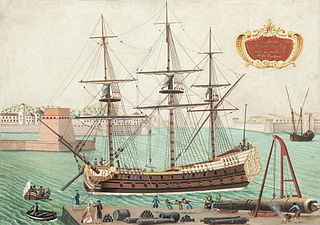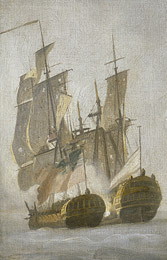Eight vessels of the British Royal Navy have been named HMS Minerva, after the goddess Minerva of Roman mythology.

The action of 3 July 1810 was a minor naval engagement of the Napoleonic Wars, in which a French frigate squadron under Guy-Victor Duperré attacked and defeated a convoy of Honourable East India Company East Indiamen near the Comoros Islands. During the engagement the British convoy resisted strongly and suffered heavy casualties but two ships were eventually forced to surrender. These were the British flagship Windham, which held off the French squadron to allow the surviving ship Astell to escape, and Ceylon. The engagement was the third successful French attack on an Indian Ocean convoy in just over a year, the French frigates being part of a squadron operating from the Île de France under Commodore Jacques Hamelin.

La Minerve was a newspaper founded in Montreal, Lower Canada by Augustin-Norbert Morin to promote the political goals of Louis-Joseph Papineau's Parti patriote. It was notably directed by Ludger Duvernay in its earlier years. It existed from 1826 to 1837, and again from 1842 to May 27, 1899. Throughout the years, it went from being a radical paper to a conservative one.

Minerve was a 40-gun Minerve-class frigate of the French Navy. The British captured her twice and the French recaptured her once. She therefore served under four names before being broken up in 1814:
Fifteen ships of the French Navy have borne the name Minerve, in honour of the Greek goddess Minerva.

The French frigate Minerve was originally launched in 1788 for the Portuguese Navy, where she served under the dual names of Nossa Senhora da Vitória and Minerva. The French Navy captured and renamed her in November 1809, after which she played a notable role in the Indian Ocean campaign of 1809-1811, participating in the defeat of a Royal Navy frigate squadron at the Battle of Grand Port, but at the surrender of Mauritius in December 1810, the ship was handed over to the British, and seems to have been broken up soon afterwards.

Ten ships of the French Navy have borne the name Junon, in honour of Juno:

HMS Dido was one of the twenty-seven Enterprise class of 28-gun sixth-rate frigates in service with the Royal Navy during the late eighteenth and early nineteenth centuries. Dido was commissioned in September 1787 under the command of Captain Charles Sandys. She participated in a notable action for which her crew would later be awarded the Naval General Service Medal; her participation in a campaign resulted in the award of another. Dido was sold for breaking up in 1817.
Many ships of the French Navy have borne the name Vénus in honour of the Roman goddess of love Venus:
Three ships of the Royal Navy have borne the name HMS Minerve, a French form of Minerva, a goddess in Roman mythology:
A number of vessels of the French Navy have borne the name Iris.

HMS Minerva was one of the four 32-gun Southampton-class fifth-rate frigates of the Royal Navy. She was launched in 1759 and served through the Seven Years' War, but was captured in 1778 during the American Revolutionary War and served as the French Minerve until being recaptured in 1781 and renamed HMS Recovery. She was broken up in 1784.
Five ships of the French Navy have borne the name Melpomène, in honour of the muse Melpomene.
The Minerve class was a type of 40-gun frigate of the French Navy, carrying 18-pounder long guns as their main armament. Six ships of this type were built at Toulon Dockyard, and launched between 1782 and 1794. The frigates served the French Navy briefly during the French Revolutionary Wars. The Royal Navy captured all six between 1793 and 1799 and took them into service, with all but one serving in the Napoleonic Wars, and some thereafter.

Minerve was a Téméraire-class 74-gun ship of the line, later razeed and commissioned as a frigate. Started during the Empire, she was launched during the Bourbon Restoration, rebuilt during the reign of Louis-Philippe, and served as a gunnery school through the French Second Republic and the Second French Empire, only to be broken up shortly after the advent of the French Third Republic.
Twelve ships of the French Navy have been named Cérès:
Minerva was the French letter of marque Minerve, a former privateer from Bordeaux, that the Royal Navy captured in September 1804. Samuel Enderby & Sons purchased her c.1805 for use as a whaler. She was taken off the coast of Peru circa August 1805 after a crewman had killed her captain and her crew had mutinied.
At least two ships of the French Navy have been named Pallas:
This page is based on this
Wikipedia article Text is available under the
CC BY-SA 4.0 license; additional terms may apply.
Images, videos and audio are available under their respective licenses.







